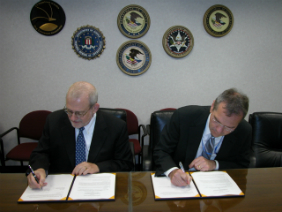Archival Notice
This is an archive page that is no longer being updated. It may contain outdated information and links may no longer function as originally intended.
Dr. John H. Laub, Director
I have on numerous occasions championed a scientific, comprehensive approach to meeting the challenge of reducing crime and promoting justice. That is why I was especially pleased when the National Science Foundation's Assistant Director, Myron Gutmann, joined me on September 10, 2012, to sign a Memorandum of Understanding between our two agencies. Myron leads NSF's Directorate for the Social, Behavioral & Economic Sciences. I am encouraged by the combined intellectual muscle we will be able to apply to solving some of the most entrenched criminal justice problems that affect individuals, communities, and even families across generations.

Congress created NSF in 1950 as an independent federal agency to promote the progress of science. Although NSF's scientific interests are far broader than NIJ's, we have overlapping interests, specifically in the social, behavioral and forensic sciences as they relate to the juvenile and criminal justice systems. For example, a large part of NIJ's portfolio focuses on applied research in the criminal justice system, and NSF's portfolio has a large focus on basic research. Through the MOU — which we signed on September 10, 2012 — I believe we have established the framework for a partnership that will help our two agencies leverage our strengths.
Like the other MOUs I have signed in the area of forensic sciences with the Netherlands and Australia and New Zealand, this one is specifically designed to promote fiscal efficiencies through interagency activities. I am certain the MOU will be both the impetus for joint intellectual engagements and the mechanism to avoid duplications.
What does this MOU mean operationally? For one thing, it gives NIJ and NSF greater flexibility to leverage resources to identify and sponsor research, development and evaluations in similar subject areas. We are working to identify opportunities where we can collaborate. We will be coordinating workshops and other educational and networking opportunities for government staff, researchers and practitioners in the field. And, although each agency will continue to conduct the review process for its own grant-making, we will consult with one another where a partnership might result in a better outcome. For example, if one agency cannot provide sufficient funding for an outstanding proposal, the other agency may be interested in a joint funding arrangement so the government's dollars can go further. Or, if a proposal is not quite suitable for one agency, the researcher may be asked to resubmit it to the other agency.
One year ago this month, I established the Office of Research Partnerships. As I stated in a previous Director's Corner, although there has been a long history of partnerships at NIJ, this new office will build relationships, leverage and share resources, and expand NIJ's network into traditional criminal justice areas as well as new areas of inquiry. Since I was in graduate school, I have been impressed with NSF's scientific endeavors. Therefore, the MOU signing between NIJ and NSF represents a particularly rewarding benchmark. Indeed, this is precisely the type of work I envisioned could be accomplished through an office dedicated to partnership-building.

